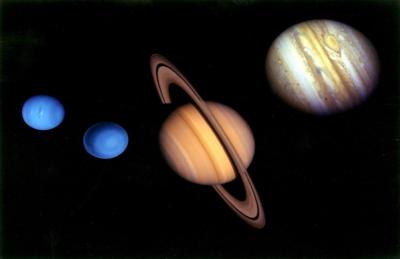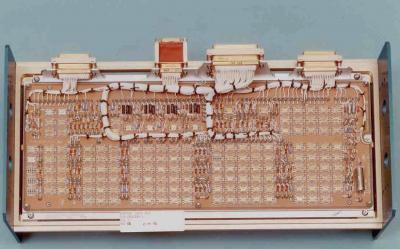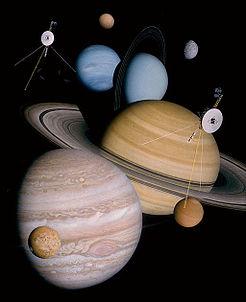Leland Langston Sr. Engineer, Ground Communications System for the Apollo lunar landing project; Lead system engineer for the Data Storage System on the Viking Mars lander project and Voyager outer planets mission; Texas Instruments Fellow. (retired)
Published: 29 Aug 2017

CTN Issue: August 2017
A note from the editor:
Usually I come up with a (I like to think) cute title for the email announcement for the CTN article, but this time I’m afraid I am too in awe of the topic to do so. So I will stick with what our author, Leland gave to me. It is with a certain amount of childhood excitement that I’d like to present a comms engineering slant on the now 40 year old and still going Voyager mission, told by one of the engineers who was there. For me Voyager is one of those moments in time that any self-respecting engineer would sell their back teeth to have been part of. The sheer challenge of communication over such distances using, what now is, such primitive technology, to achieve one hell of a phone call at some quite decent data rates would make the bravest of us quiver. Before the mission launch all the engineers got their names engraved on a plaque on the probe and it is now leaving the solar system. I don’t think 5G will ever provide that level of satisfaction unfortunately! And by the way, when this article talks about free space loss, it really means free space….. Maybe there are some other Voyager engineers out there who will want to add their comments?
Alan Gatherer, Editor-in-Chief
Voyager - A Space Exploration Mission like no other

Figure 1: Leland Langston, System Engineer, Voyager Data Storage Subsystem, Texas Instruments

Figure 2: Texas Instruments Voyager Engineering Team, 1975
Pre-Launch History of the Voyager Program
The world changed on October 4, 1957 with the launch of Sputnik 1. It weighed only 83.6 kg. (183.9 pounds), and took about 98 minutes to orbit the Earth. I was in high school and remember listening in awe to the “beep, beep, beep” on my home-built short wave receiver. The event catalyzed the U.S. commitment to space exploration that continues today. There are few national programs that result in the dividends returned on investments such as this--for the United States and for the world at large. Electronics was still mostly based on vacuum tube technology and the transistor had been invented only about nine years earlier. The world’s first commercially produced digital computer, the Univac 1, had been delivered to the census bureau only six years before, and used 5,200 vacuum tubes. Four years later, on May 25, 1961, President John F. Kennedy announced before a special joint session of Congress the dramatic and ambitious goal of sending an American safely to the Moon before the end of the decade. Such was the state of technology and the political atmosphere in the U.S at the beginning of the Space Age. Some astrological believers called this time the “…dawning of the Age of Aquarius”. Although an astrologically motivated term, it is a very real astronomical phenomenon that will occur in the not too distant future, affecting how we view the stars and constellations surrounding our solar system, and in this context it has in fact begun.
The U.S. embarked on several unmanned space exploration programs in the ‘60s. The first successful interplanetary mission (U.S.) was the Mariner 2, launched in August 1962. It successfully flew by Venus and returned significant new science data. Then followed 8 more Mariner spacecraft culminating in 1973 with Mariner 10 (also called Mariner Venus-Mercury) with a total cost of only $554 million. Mariner 9 orbited Mars and was the first spacecraft to orbit another planet. It returned significant science data including the best close-up images of Mars that had been obtained at that time. At this time, all deep space missions had been confined to the inner planets (Mercury, Venus and Mars). It was then that NASA began considering a program to explore the outer gas giants (Jupiter, Saturn, Uranus and Neptune) to complete a study of all major planets. The concept of the Grand Tour began in 1964, when Gary Flandro of the Jet Propulsion Laboratory (JPL) noted that an alignment of Jupiter, Saturn, Uranus, and Neptune would occur in the late 1970s that would enable a single spacecraft to visit all of the outer planets by using gravity assists. This particular alignment occurs once every 175 years. By 1966, JPL was promoting the project, noting it would allow a complete survey of the outer planets in less time and for less money than sending individual probes to each planet. JPL began promoting it with a December 1966 article penned by Homer Joe Stewart, head of JPL's advanced mission planning.

Voyager can be said to have begun in 1965 as a Grand Tour, an extensive, if not grandiose, planetary mission planned in the midst of shrinking NASA and Federal budgets, at a time when NASA sought to define its mission in the post-Apollo era. This mission was estimated to cost over $1 billion when the entire NASA budget for 1972 was only slightly over $3 billion in 1972. It was truly a “big science” project. In response to social and political pressure on the Federal budget stemming largely from the Great Society programs and the Vietnam War, as well as the conservative fiscal policy of the Nixon administration, the Grand Tour mission was downsized. Congressional pressure, combined with internal competition from the recently approved Space Shuttle program, led to the decision to cancel the Grand Tour project in December 1971; it was replaced by a proposal to visit only two planets using a pair of Mariner-derived probes. The Mariner Jupiter-Saturn project was approved in early 1972, with an estimated cost of $360 million. The probes would be built by JPL, with the intention that they would last long enough to complete the original Grand Tour of the four giant planets, but be advertised as missions to only Jupiter and Saturn to reduce estimated total project costs. It was initially called the Mariner Jupiter-Saturn (MJS) mission. In March 1977, just a few months before launch, NASA held a competition to rename the project; it then became known as Voyager. Thus was the auspicious beginning of the Voyager project. As a young engineer fresh off of the Apollo project and the Viking project, this was a “dream project” for me. It is one of the highlights of my career.

Spacecraft Design Summary
Voyager carried twelve science instrument subsystems. These are:
- "CRS – COSMIC RAY SUBSYSTEM".
- "ISS NA – IMAGING SCIENCE SUBSYSTEM – NARROW ANGLE".
- "ISS WA – IMAGING SCIENCE SUBSYSTEM – WIDE ANGLE".
- "IRIS – INFRARED INTERFEROMETER SPECTROMETER AND RADIOMETER".
- "LECP – LOW ENERGY CHARGED PARTICLE".
- "MAG – TRIAXIAL FLUXGATE MAGNETOMETER".
- "PLS – PLASMA SCIENCE EXPERIMENT".
- "PPS – PHOTOPOLARIMETER SUBSYSTEM".
- "PRA – PLANETARY RADIO ASTRONOMY RECEIVER".
- "PWS – PLASMA WAVE RECEIVER".
- "RSS – RADIO SCIENCE SUBSYSTEM".
- "UVS – ULTRAVIOLET SPECTROMETER".

These twelve instruments are arranged as shown in Figure 5. In addition to the nine instruments shown on booms, three are contained in the 10-sided polygon bus housing electronics. This bus also houses seven engineering subsystems including the data storage subsystem, the flight data subsystems, the telemetry modulation/demodulation subsystem, the attitude and Articulation Control Subsystem, the radio communications subsystem, and the power supply subsystem. The primary antenna is the 3.7 meter diameter high-gain antenna. This antenna supports both S-band and X-band communications.
The physical characteristics of the spacecraft are summarized as follows. The mission module after injection weighed 825 kilograms (1,819 pounds) including a 117-kg (258-Ib.) science instrument payload. The propulsion module, with its large solid-propellant rocket motor, weighed 1,207 kg (2,660 lb.). Launch weight of the spacecraft was 2,066 kg (4,555 lb.).
Communications Subsystem Operation
Communications with the Voyagers is by radio link between Earth tracking stations and a dual-frequency radio system aboard the spacecraft. The uplink operates at S-band only, carrying commands and ranging signals from ground stations to one of a pair of redundant receivers. The downlink is transmitted from the spacecraft at either S-band or X-band frequencies.
The flight data subsystem, one of the three on-board computers controls the science instruments and formats all science and engineering data for telemetry to Earth. The telemetry modulation unit of the modulation demodulation subsystem feeds data to the downlink. The flight command unit of the modulation/demodulation subsystem routes ground commands received by the spacecraft.
Only one receiver is powered ON at any one time, with the redundant receiver at standby. The receiver operates continuously during the mission at about 2113 megahertz. (Different frequency ranges have been assigned to the radio-frequency subsystem of each spacecraft.) The receiver can be used with either the high-gain (dish) or low-gain (Omni) antenna. (Voyager 2's primary receiver failed on April 5, 1978, and the spacecraft is operating on its backup receiver.)
The S-band transmitter consists of two redundant exciters and two redundant RF power amplifiers, of which any combination is possible. Only one exciter-amplifier combination operates at any one time. Selection of the combination is by on-board failure-detection logic within the computer command subsystem, but with ground-command backup. The same arrangement of exciter/amplifier combinations makes up the X-band transmitting unit.
One S-band and both X-band amplifiers employ traveling wave tubes. The second S-band unit is a solid state amplifier. The S-band transmitter is capable of operating at 9.4 watts or at 28.3 watts when switched to high power and can radiate from both antennas. X-band power output is 12 watts and 21.3 watts. X-band uses only the high-gain antenna. (S-band and X-band never operate at power simultaneously.)
When no uplink signal is being received, the transmitted S-band frequency of about 2295 MHz and X-band frequency of 8418 MHz originate in the S-band exciter's auxiliary oscillator or in a separate ultra-stable oscillator (one-way tracking). With the receiver phase-locked to an uplink signal, the receiver provides the frequency source for both transmitters (two-way tracking). The radio system can also operate with the receiver locked to an uplink signal while the downlink carrier frequencies are determined by the on-board oscillators (two-way non-coherent tracking). Only the 64-m (210-ft.) antenna stations of the Deep Space Network can receive the downlink X-band signal.
The high-gain antenna, with its 3.66-m-diameter (12 ft.) parabolic reflector, provides a highly directional beam. The low- gain antenna provides essentially uniform coverage in the direction of Earth. After the first 80 days of the mission, all communications -- both S-band and X-band -- have been via the high-gain antenna.
Power
Because of the extreme distances from the sun, and hence low light intensity, the Voyager spacecraft required a different primary power source. Voyager was one of the first spacecraft to use Radioisotope Thermoelectric Generators (RTGs) as the primary power source. The power source was the Pu238 isotope of Plutonium with a half-life of 87 years. Three RTG modules produced approximately 2,400 watts thermal, but the efficiency of the thermocouples is very low, and only about 160 watts of electricity was produced by each module to yield less than 500 watts at mission start. Because the Plutonium decays to produce half power after 87 years, the power output has steadily decreased to only about 300 watts after 40 years. The voltage from the RTGs is DC and varies over time. Hence power conditioning was used to convert the output to a 2400 Hz square wave tightly regulated voltage which was distributed to each electronics package. Each electronic subsystem then converted this voltage to the voltages required by the subsystem.
Downlink Telemetry
Data telemetered from the spacecraft consists of engineering and science measurements prepared for transmission by the flight data subsystems, telemetry modulation unit and data storage subsystem.
The encoded information includes voltages, pressures, temperatures, television pictures and other values measured by the spacecraft telemetry sensors and science instruments. See Figures 7 and 8 for some images received from Voyager.
Because spacecraft maneuvers during encounters prevented the antenna from being continuously pointed toward earth, as well as the rate at which data was collected during the planet and moon encounters was too high for real-time transmission, this data was stored on a digital tape recorder for later play-back at a much lower rate. The data storage subsystem consisted of a digital tape recorder and associated electronics. The tape recorder consisted of a belt driven mechanism powered by a servo-controlled brushless DC motor. (This was one of the first designs using a brushless DC motor.) The tape was a little over 1000 feet in length and stored data using Miller encoding to yield approximately 6700 bits/inch packing density. The recorder had nine parallel tracks--eight data tracks and one tachometer track that was used for servo control of the brushless DC motor. The tape could store approximately 650 Mb (80 MB) of data (although only 536 Mb of data storage capacity was deemed reliable over the mission lifetime). Data was typically recorded at 115 kbps, and could be played back in non-real time at data rates of 57.6; 33.6; 21.6 and 7.2 kbps with the lower rates used at the greater distances (e.g., from Neptune). These are the actual information rates; the information was encoded for error correction using a rate 1/2, constraint length 7 convolution code before transmission. (The difficult task of decoding was done on the ground using a Viterbi decoder.)
The received signal-to-noise (Eb/No) ratio was near the noise threshold when the spacecraft was near Neptune, even with a system noise temperature of 25oK. The rate 1/2 error correction code resulted in a Bit Error Rate of approximately 10-5. The link budget calculations (approximate) are shown in Table 1.
The success of Voyager is measured in terms of the data returned as well as its record for longevity. The Voyager 1 spacecraft entered interstellar space in August 2012, 35 years after launch. Quite remarkable for a system designed for a four-year mission in the ‘70’s when the state of the art for integrated circuits was MSI with the highest level of integration being a 4-bit counter, and the imaging device being a Vidicon imaging tube! And like the bunny in the battery commercial, “It keeps going and going and going”.
| X-Band Downlink | 64 meter Earth Antenna, X-band | |||
| Antenna Diameter, m | 3.66 | Ant Dia, m | 64 | |
| Antenna aperture Area, A, m2 | 1.05E+01 | Antenna aperture Area, A m2 | 3.22E+03 | |
| c, speed of light, m/s | 3.00E+08 | c, speed of light, m/s | 3.00E+08 | |
| f, Hz | 8.42E+09 | f, Hz | 8.42E+09 | |
| l2 ,wavelength in m2 | 1.27E-03 | l2 ,wavelength in m2 | 1.27E-03 | |
| Ant efficiency h | 6.00E-01 | Ant efficiency h | 7.00E-01 | |
| G | 6.25E+04 | G | 2.23E+07 | |
| G, dB | 4.80E+01 | G, dB | 7.35E+01 | |
| Pout (PA), W | 2.13E+01 | |||
| Pout, dBW | 1.33E+01 | Eb/No Calculations | ||
| EIRP, dBW | 6.12E+01 | Min Data Rate, bps | 7200 | |
| NEB (estimated), Hz | 8000 | |||
| Path Loss, X-Band | Boltzmann’s constant, k | 1.38E-23 | ||
| Distance to Neptune, max, km | 4.70E+09 | Estimate Noise Temp, deg K | 25 | |
| Free space loss, dB | 3.04E+02 | Noise Power Density, No | 3.45E-22 | |
| RX power, dBm | -1.40E+02 | Eb | 1.49608E-21 | |
| RX power, W | 1.08E-17 | Eb/No | 4.34E+00 |

Figure 6: Photograph of one of the Multilayer PCBs for Voyager

Figure 7: Montage of the four outer planets taken by Voyager

Figure 8: Montage of the four gas giants and some of their moons photographed by Voyager
References
- Freeman, Roger L., Radio System Design for Telecommunications, second edition, John Wiley and sons, New York, 1997, ISBN 0-471-16260-4.
- Spilker, James L., Digital Communications by Satellite, Prentice Hall, Englewood Cliffs, New Jersey, 1977, ISBN 0-13-214155-8.
- Roddy, Dennis, Satellite Communications, Third Edition, McGraw-Hill, New York, 2001, ISBN 0-07-137176-1
- Fisher, Sharon, “NASA’s Voyager Used 8-Track Tape to Go Into Space”, SEP 30 2013, http://itknowledgeexchange.techtarget.com/
- NASA News Release, “Voyager Backgrounder, October 1980.
- NASA Jet Propulsion Laboratory, “Voyager Instruments, https://voyager.jpl.nasa.gov/mission/spacecraft/instruments/
- Wikipedia, the free encyclopedia, “Voyager program”, https://en.wikipedia.org/wiki/Voyager_program
- Butrica, Andrew J., Chapter 11, “Voyager: The Grand Tour of Big Science”, https://history.nasa.gov/SP-4219/Chapter11.html
- NASA Jet Propulsion Laboratory, “Galleries of Images Voyager Took”, https://voyager.jpl.nasa.gov/galleries/images-voyager-took/
Statements and opinions given in a work published by the IEEE or the IEEE Communications Society are the expressions of the author(s). Responsibility for the content of published articles rests upon the authors(s), not IEEE nor the IEEE Communications Society.


